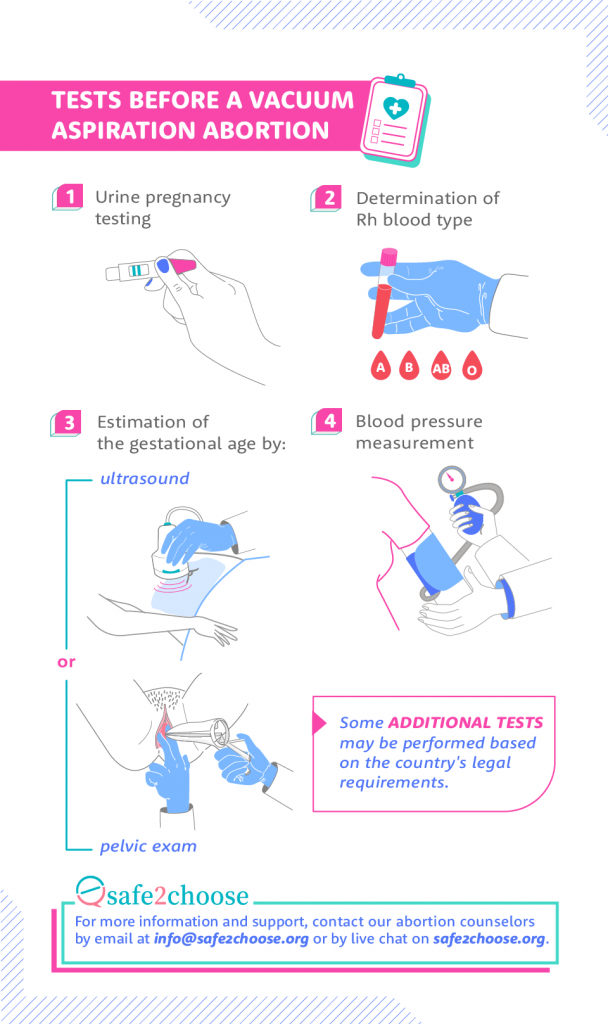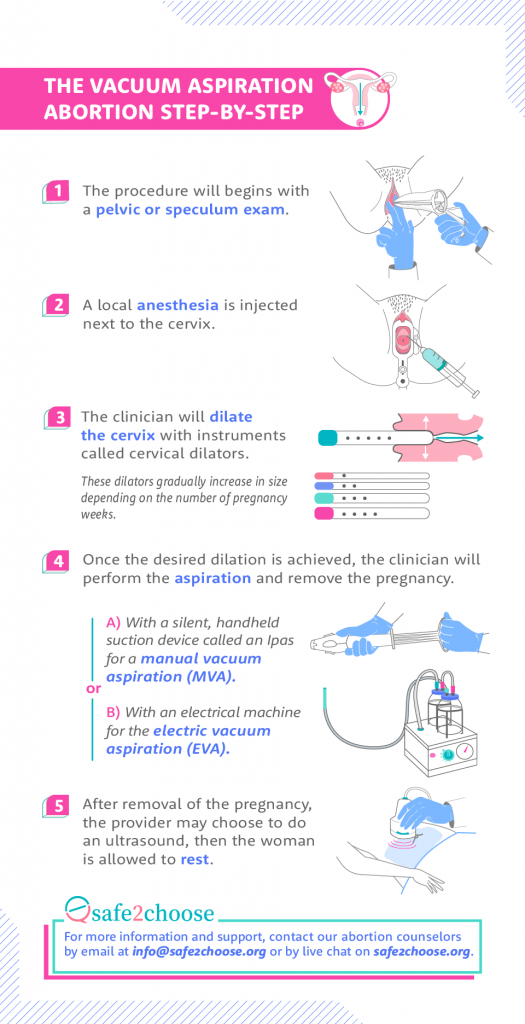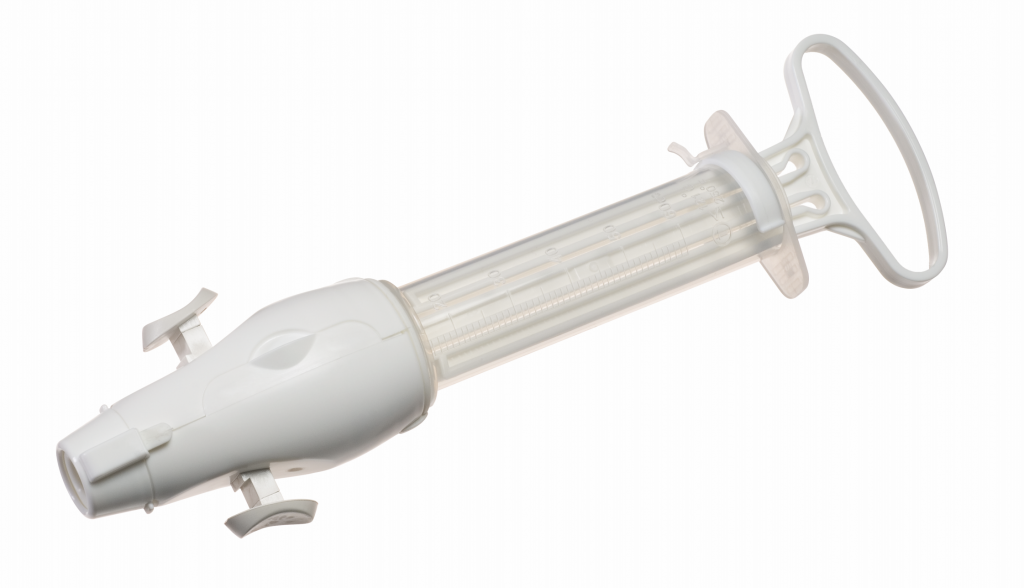
A manual vacuum aspiration abortion (MVA) or an electric vacuum aspiration abortion (EVA) are types of in-clinic abortions that can be performed up to 14 weeks (MVA) and 15 weeks (EVA) of pregnancy. This page details information about these procedure abortions.
What is a Manual Vacuum Aspiration (MVA) Abortion?
Manual vacuum aspiration (MVA) is a very safe method of abortion for pregnancies in the first trimester, and/or early second trimester all the way up to 14 weeks of gestation [1]. The gestational age limit for MVA often depends on the clinic, as well as the healthcare provider performing the procedure.
MVA is performed by a trained provider in a clinic.
During the procedure the clinician uses instruments, including a silent suction device, to remove the pregnancy from the uterus [2]. Most commonly this procedure is performed using local anaesthesia while the woman is awake, and it takes typically between 5 and 10 minutes. The woman is likely to experience cramping during the procedure, and there may be some bleeding on and off for several days or weeks afterwards.
MVA is Manual Vacuum Aspiration but it might also be known as surgical abortion, aspiration abortion, suction abortion, vacuum aspiration procedure abortion, or in-clinic abortion. [1]
What is an Electric Vacuum Aspiration (EVA) abortion?
Electric Vacuum Aspiration (EVA) is a safe and very similar method to Manual Vacuum Aspiration (MVA). EVA can be used for pregnancies in the first trimester, and/or early second trimester. EVA is performed by a trained provider in a clinic.
During the procedure, the clinician uses instruments, including an electric vacuum suction to remove the pregnancy from the uterus.
The primary difference between EVA and MVA is that electricity is used to create suction to remove the pregnancy. Because the EVA requires electricity, it may not be available in low-resource settings. Where available, clinicians may use this method of EVA as the gestational age increases after 10-12 weeks because it allows the clinician to perform the procedure more quickly than the MVA, and thus decreases the procedure duration for the woman. Another significant difference is that there is noise associated with the EVA machine because it uses electricity. [2]
What happens during a manual vacuum aspiration abortion procedure?
1/ Medication before a vacuum aspiration abortion
The World Health Organization (WHO) recommends administering antibiotics prior to manual vacuum aspiration and electric vacuum aspiration. This helps to reduce the risk of infection. [1]
However, if antibiotics are unavailable, a vacuum aspiration abortion can still safely be performed. Clinics may also choose to give an oral medication to help with the cramping pain, such as Ibuprofen. [2]
2/ In preparation for the vacuum aspiration abortion

During a clinic visit for a manual vacuum aspiration abortion (MVA) or an electric vacuum aspiration abortion (EVA), there are often steps taken in preparation for the procedure including (but not limited to) [2]:
- Urine pregnancy testing
- Determination of Rh blood type
- Manual pelvic exam and/or ultrasound to estimate the gestational age
- Blood pressure measurement
Some additional tests may be performed based on requirements/laws specific to each geographic location.
3/ During the manual vacuum aspiration abortion
Step 1. The manual vacuum aspiration abortion (MVA) or the electric vacuum aspiration abortion (EVA) procedures will begin with a pelvic or speculum exam.
Step 2. A local anesthesia is most commonly injected next to the cervix.
Step 3. The clinician will then begin to dilate the cervix with instruments called cervical dilators. These dilators gradually increase in size, and this step is guided by the number of weeks of gestation of the pregnancy.
Step 4. Once the desired dilation is achieved, the clinician will either use a silent, handheld suction device called an Ipas for an MVA, or an electric device for an EVA to perform the aspiration and remove the pregnancy.
Step 5. After removal of the pregnancy, the provider may choose to do an ultrasound, and then the woman is allowed to rest. [2]

4/ After the manual vacuum aspiration abortion
The manual vacuum aspiration abortion (MVA) or the electric vacuum aspiration abortion (EVA) recovery time is relatively short in the clinic.
- For women who have the procedure with only local anesthetic, the recovery time is typically less than 30 minutes.
- For women who were given a sedation medicine for the procedure, the recovery time may be a bit longer (30-60 minutes) while the sedation effect diminishes.
Once the in-clinic abortion recovery is completed, the woman is sent home. Some clinics may request that she have an escort or someone with her to get home, but this depends on the clinic. [2]
5/ Post-abortion care after the manual vacuum aspiration abortion
After a safe in-clinic abortion, women are often offered a follow-up visit, and while this is not required, each woman should listen to the recommendation of her healthcare provider.
There is no medically proven amount of time that a woman has to wait to do specific activities including shower/bathing, exercise, sex, or using tampons. Generally, it is advised that at least until the bleeding lightens after the procedure, the woman should avoid introducing objects into the vagina including tampons and menstrual cups, and avoid intense physical activity. Each woman can return to her normal activities as tolerated, and each woman will be different.
Prior to leaving the clinic, women should be offered information about methods of contraception. Most forms of contraception can be started immediately, however, a discussion should take place regarding each woman and her choice of method. Clinics should provide women with contact information, in case they have questions or concerns after the abortion. [2]
To find the appropriate contraceptive methods of your choice, visit www.findmymethod.org
The manual vacuum aspiration (MVA) equipment used during the procedure
Manual vacuum aspiration (MVA) involves the use of a convenient, handheld device called an Ipas. The Ipas is a silent, suction device that is used to aspirate the pregnancy. [2] More information about the Ipas device can be found here.

The electric vacuum aspiration (EVA) equipment used during the procedure
Electric vacuum aspiration (EVA) uses a machine that creates suction, which is connected to a tube that the clinician inserts through the cervix to aspirate the pregnancy. The EVA device often creates a humming/buzzing noise during aspiration.
Most commons side effects of the vacuum aspiration abortions
The most common pain associated with vacuum aspiration abortions is strong cramps experienced by the woman during the procedure. Often this cramping will improve quickly afterwards, but some women may experience cramping on and off for a few days or weeks. This side effect is best managed with NSAID medications such as ibuprofen.
Local anesthesia is often used during vacuum aspiration abortions, and this helps to numb the area around the cervix to ease some of the pain during the procedure. [1]
Most women will experience bleeding and cramping during and after vacuum aspiration abortions, these symptoms will gradually improve in the following days after the procedure.
It is also common to experience many different emotions after an in-clinic abortion, all of which are valid, and if the woman feels like she needs additional help, she should seek counseling care. [1]
Risks of complications of the vacuum aspiration abortions
While vacuum aspiration abortions are very safe, there are still some risks to the procedure which include: heavy bleeding, infection, injury to the uterus and surrounding structures, incomplete abortion.
These risks are very small when the procedure is performed by a trained clinician, but they are important to know when consenting to a procedure.
A routine vacuum aspiration abortion procedure without complications does not lead to future infertility. [1]
After a vacuum aspiration abortion, there are a few signs that women should pay attention to and seek clinical attention in case of [2]:
- Heavy bleeding (completely soaking 2 pads per hour for 2 hours in a row or more)
- Fevers (more than 38C or 100.4F) more than 24 hours after the procedure
- Severe, worsening pelvic pain
- Continued signs of pregnancy (increasing nausea, breast tenderness, etc.)
For more information
Get in touch with our counselors to get more information on the in-clinic abortion such as the MVA or the EVA procedure and receive support on the most appropriate abortion methods depending on your situation. You can also learn more about the other method, an abortion with pills if you are under 13 weeks pregnant.
by the safe2choose team and supporting experts at carafem, based on the 2019 recommendations by Ipas, and the 2012 recommendations by the WHO.
carafem provides convenient and professional abortion care and family planning so people can control the number and spacing of their children.
Ipas is the only international organization solely focused on expanding access to safe abortion and contraceptive care.
WHO is a specialized agency of the United Nations responsible for international public health.
[1] World Health Organization (WHO). Safe abortion: technical and policy guidance for health systems, second edition. 2012. Retrieved from: https://apps.who.int/iris/bitstream/handle/10665/70914/9789241548434_eng.pdf;jsessionid=F77B761669FC579124C1E9CA2CC3CFDB?sequence=1
[2] Ipas. Clinical Updates in Reproductive Health. 2019. Retrieved from: https://www.ipas.org/wp-content/uploads/2023/09/Ipas-Clinical-Updates-in-Reproductive-Health-CURHE23b.pdf